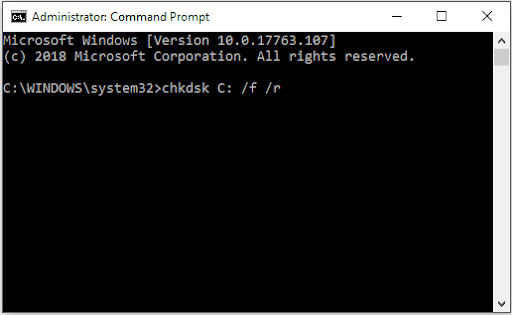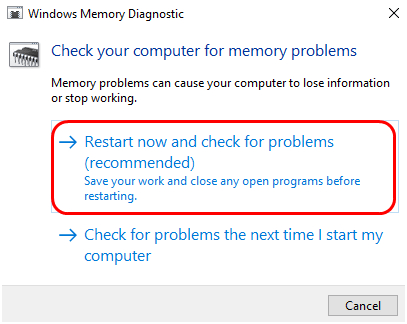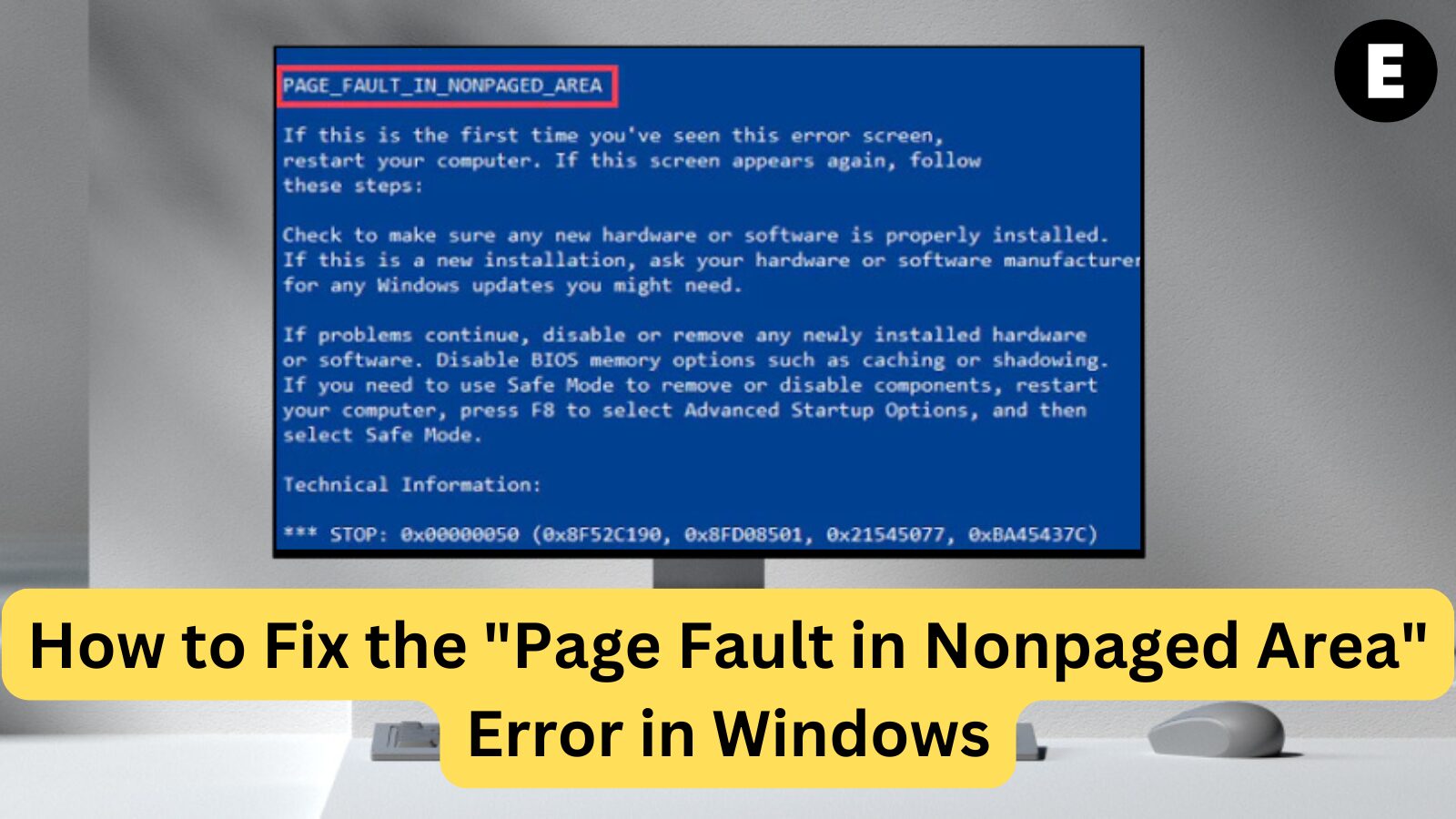Many Windows 10 users have reported encountering the Page Fault in Nonpaged Area error. This Page Fault in Nonpaged Area issue is one of the most dreaded Blue Screen of Death (BSOD) errors you definitely don’t want to face. It can be highly frustrating and challenging to troubleshoot effectively.
If you’ve encountered the Windows 10 Page Fault in Nonpaged Area error, follow the solutions in this guide to resolve it.
Understanding the Page Fault in Nonpaged Area Error
Many Windows users have reported encountering the Page Fault In Nonpaged Area (or PAGE_FAULT_IN_NONPAGED_AREA) error. This is a Blue Screen of Death (BSOD) error with the error code STOP: 0x00000050 (0xCD3DD628, 0x00000001, 0x804EFC9A, 0x00000000).
When you experience the Page Fault In Nonpaged Area error, you might also see some additional error messages, such as:
- Driver names like ntfs.sys or ntoskrnl.exe
- Stop: 0x00000050
- STOP: 0x50 error, etc.
The STOP: 0x00000050 error indicates that the system was attempting to request a page in memory to continue operations, but the required page was unavailable, preventing Windows OS from completing the process.
The Page Fault In Nonpaged Area error can lead to some negative effects, such as:
- Frequent OS crashes
- Loss of valuable data
- Hardware malfunctions
- Inaccessible programs on Windows OS
This error can be very disruptive, so it’s important to resolve it quickly.

What Causes the Page Fault In Nonpaged Area Error?
The Page Fault In Nonpaged Area error (with the 0x00000050 error code) can arise from both software and hardware issues. Microsoft identifies several potential causes for this error, including:
- Aborted or incomplete Windows updates
- Driver conflicts or incompatible third-party programs (such as printers and antivirus programs)
- Faulty RAM or corrupted memory
- Corrupted registry files
- Malware infections
How to Fix the Page Fault In Nonpaged Area Error in Windows 10
Follow these solutions to fix the Page Fault In Nonpaged Area Error in Windows 10:
Preliminary Workarounds
Before diving into technical solutions, perform the following workarounds to ensure the error isn’t caused by a basic system issue:
- Reboot your PC and see if the problem resolves.
- Scan your PC for malware to remove any infections blocking Windows updates.
- Temporarily disable third-party antivirus or firewall programs, then test again to see if the issue persists.
If these initial steps don’t fix the error, proceed to more technical solutions.
Note: Make sure to create a Windows restore point before proceeding with the following solutions to protect your system.
Fix #1: Undo Recent Windows Changes
To address the Page Fault In Nonpaged Area error by undoing recent changes, you need to boot Windows 10 in Safe Mode and reverse any recent updates or software installations that might be causing the issue.
Steps to Start in Safe Mode:
- Click the Start button.
- Select the Power icon.
- Hold the Shift key and click Restart.
- Select Troubleshoot > Advanced Options > Startup Settings.
- Click Restart.
- After your PC reboots, select Option 4 to enable Safe Mode (or Option 5 for Safe Mode with Networking).
Once in Safe Mode, you can either run anti-malware software or uninstall recent updates that might be triggering the error.
Fix #2: Uninstall Third-Party Antivirus Programs
Some antivirus programs can cause false positives or driver conflicts that lead to the Page Fault In Nonpaged Area error. If disabling the antivirus software doesn’t resolve the issue, try uninstalling it.
Before uninstalling, conduct a full system scan to ensure no malware is causing the issue.
Fix #3: Check Hard Drive for Errors
To resolve the Page Fault In Nonpaged Area error, run a disk check to find and fix any hard drive issues. You can use the built-in Windows tools for this.
Steps to Perform a Disk Check:
- Press Windows Key + S and type CMD to open Command Prompt.
- Right-click and select Run as Administrator.
- Type (or copy-paste)
chkdsk c /fand press Enter. This will check and fix file system errors on the C: drive. - For more advanced repairs, use the
chkdsk c /rcommand to check for physical hard drive issues. - You can also run both commands simultaneously using
chkdsk c /f /r.

Once the check completes, restart your device to see if the error is resolved.
Fix #4: Run Windows Memory Diagnostic Tool
A common cause of the STOP: 0x00000050 error is a problem with your Random Access Memory (RAM). If your PC’s RAM is failing, it can trigger this error. Fortunately, Windows provides a built-in tool, Windows Memory Diagnostic, to help check for RAM issues and report any problems.
Steps to Use the Windows Memory Diagnostic Tool:
- Press Windows Key + S to open the search bar.
- Type memory diagnostic into the search box.
- Choose Windows Memory Diagnostic.
- You’ll be given two options:
- Restart your computer now and check for problems immediately (recommended).
- Check for problems the next time you start your computer (this option allows Windows to scan your memory before it fully loads).

- Select the option that works best for you, and wait for the tool to finish the check.
- If any issues are found, follow the suggestions provided to resolve the problem.
Fix #5: Disable Automatic Paging
Disabling Automatic Paging in Windows 10 can also help resolve the Page Fault In Nonpaged Area error.
Steps to Disable Automatic Paging in Windows 10:
- Press Windows Key + E to open File Explorer.
- Right-click on This PC in the left pane and select Properties.
- Select Advanced System Settings.
- Under the Performance section, click Settings.
- In the Performance Settings window, go to the Advanced tab.
- Under Virtual Memory, click Change.
- Uncheck the box for Automatically Manage Paging File Size for All Drives.
- Click OK to save the settings, then restart your computer.
Fix #6: Update Drivers
Outdated or faulty device drivers can often trigger the Page Fault In Nonpaged Area error. To fix this, you can update, disable, or uninstall and reinstall the problematic driver.
Steps to Update Device Drivers:
- Press Windows Key + R to open the Run dialog box.
- Type devmgmt.msc and press Enter to open Device Manager.
- Locate drivers that have a yellow exclamation mark, indicating an issue.
- Right-click on the identified driver and select Update Driver Software.
- Follow the on-screen instructions to update the driver.
- If you can’t update the driver, you can disable or uninstall it. The driver will update the next time you perform a Windows Update.
Note: After updating drivers, make sure to update Windows as well to ensure you’re using the latest driver versions.
Fix #7: Check RAM (Physically)
Faulty RAM is often the culprit behind the Page Fault In Nonpaged Area error, particularly if the error occurs frequently. If your computer has multiple RAM chips, you can identify and remove the faulty one.
Steps to Check and Fix Faulty RAM:
- Power off your computer completely.
- Disconnect all power sources (unplug the power cord and remove the battery if it’s a laptop).
- Open the computer case and carefully remove the RAM strip.
- Reinsert the RAM strip back into its slot.
- Restart your computer and check if the error is resolved.
If your PC has only one RAM stick and you’ve determined that it’s faulty, replacing the RAM may be the solution.
These steps should help resolve the Page Fault In Nonpaged Area error caused by memory issues.
One more thing
If you’re in search of a software company that embodies integrity and upholds honest business practices, your quest ends here at Ecomkeys.com. As a Microsoft Certified Partner, we prioritize the trust and satisfaction of our customers. Our commitment to delivering reliable software products is unwavering, and our dedication to your experience extends far beyond the point of sale. At Ecomkeys.com, we provide a comprehensive 360-degree support system that accompanies you throughout your software journey. Your trust is our foundation, and we’re here to ensure that every interaction with us is a positive and trustworthy one.

